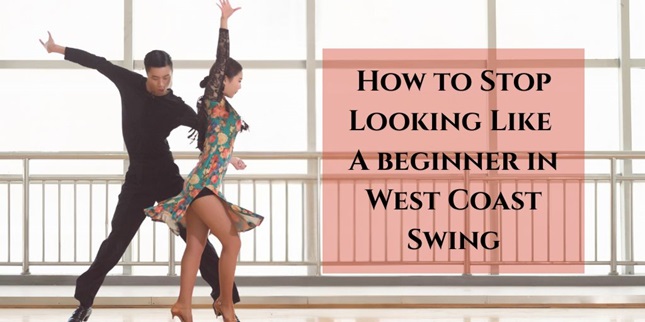Every dancer has faced the challenge of feeling out of sync while everyone else seems perfectly in rhythm.
Learning the basic groove is just your MVP (Minimum Viable Product). What sets high-performing dancers apart is how they show up on the floor.
Forget counting out loud or stepping on toes, this blog shares tips to level up your West Coast Swing in Singapore and beyond, so you can stop broadcasting as “early-stage beginner.”
1) Lock In Your Slot and Anchor
West Coast Swing is built around a mental “slot”, think of it as your dance runway. The follower moves up and down this corridor while the leader maintains minimal lateral drift. Staying in your lane keeps your dance clean, directional, and low-friction.
Equally critical is nailing your anchor step, the rhythmic “5-and-6” or “1-and-2, 3-and-4” that closes most patterns. This isn’t just perfunctory footwork; it’s your shared reset point, loaded with elastic connection.
Optimise it by keeping your weight back, your trunk engaged, and your connection intentional.
Pro Tip: Run anchor drills at a low tempo. Feel your center of gravity pivot onto your back foot and hold that tension, without going rigid.
2) Build a Dynamic Connection
Your connection isn’t static; it’s responsive elasticity. You need calibrated tension to communicate your lead/follow signals in real time.
The compression during your rock steps and anchors creates a feedback loop that amplifies musical cues.
Quick Drill: Try push–pull sequences with a partner. Lead a rock–anchor combo, then have the follower lean in and return to the starting position. Map precisely where tension initiates and releases.
View this post on Instagram
3) Master Core Patterns and Timing
Consider your foundational patterns your feature set:
-
Sugar Push: 6-count compression and release.
-
Side Passes: Smooth slot traversal.
-
Tuck Turn: Clean directional change.
-
Whip: An 8-count showcase of compression, rotation, and extension.
Don’t just memorise choreography; understand the mechanics behind each move. Timing is the backbone of consistency. Become fluent in 6- and 8-beat phrasing so you can execute with precision.
4) Tighten Footwork and Rhythm
Foot precision drives dance hygiene.
-
Anchor Footwork: Step back smoothly, landing firmly through your heel for better balance.
-
Triple Steps: Keep them balanced and deliberate.
-
Turns: Drill chainés and spot turns solo until alignment is second nature.
Workflow: Start patterns at 60–70 BPM to stress fine motor control. Gradually ramp to 120–140 BPM for real-world agility.
5) Solo Drills Are Your Secret Advantage
You don’t need a dance partner to retrofit your fundamentals. Solo practice builds deep muscle memory.
-
One-foot balance helps build core stability.
-
Anchor drills with a prop simulate a real connection.
-
Solo slot work sharpens clarity and floor awareness.
Invest in focused solo reps; this is where baseline proficiency compounds.
Read Also: Top 5 Drills to Improve Balance in Social Dance Singapore
6) Develop Musical Intelligence
West Coast Swing thrives on rhythm and nuance. Instead of relying on mechanical counting, train yourself to recognise breaks, accents, and hooks.
-
Clap rhythms or verbalise counts internally.
-
Leaders: Experiment with micro-leads, subtle lifts, compressions, or pauses that respond to the track in milliseconds.
This is how you evolve from procedural dancing to musical conversation.
7) Get Targeted Feedback Early
Group classes provide a solid foundation, but private coaching accelerates your progress by identifying and addressing blind spots, such as posture, frame, and arm lines.
Action Step: Record practice sessions on video. Audit your:
-
Arm engagement.
-
Triple-step alignment.
-
Anchor clarity.
Use these insights to iterate with purpose.
8) Layer in Styling Strategically
Once your fundamentals are dialed in, start integrating styling:
-
Head nods and arm accents synced to musical hits.
-
Controlled body rolls during slow blues.
-
Soft, intentional hand styling.
Treat these as performance enhancers, not distractions. The goal is to clean the baseline first and polish second.
9) Build Confidence Through Reps and Play
Confidence is a byproduct of volume and iteration.
-
Prioritise floor time. You’ll learn more from 10 messy social dances than 100 solo drills alone.
-
Revisit progress quarterly, record, and review.
-
Plug into community: Slack groups, Facebook communities, local socials.
Challenge Yourself: Rotate through three practice modes—one song of strict basics, one of musical accents, and one dedicated to playful experimentation.
Final Recap
To stop looking like an early-stage dancer and start operating like a seasoned pro:
-
Master slot and anchor.
-
Develop a dynamic connection.
-
Lock in timing and patterns.
-
Drill footwork to automaticity.
-
Invest in solo practice.
-
Cultivate musicality.
-
Source feedback early.
-
Style with intention.
-
Show up consistently.
Wrap Up
West Coast Swing isn’t a checklist of steps; it’s a real-time conversation powered by rhythm, connection, and creative play. Lean into focused reps, honest feedback, and regular social practice. Over time, you’ll shift from tentative to effortlessly in sync.
If you’re serious about leveling up your skills and want a supportive community to accelerate your progress, ZiggyFeet is your next step.
Keep iterating. Keep exploring. And most importantly, keep dancing.




